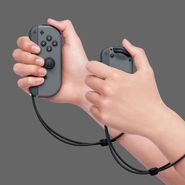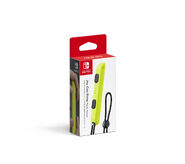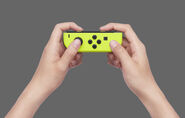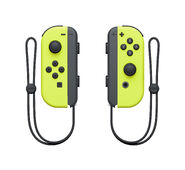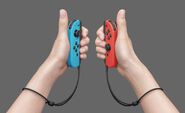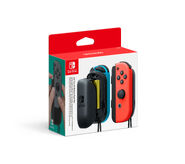|
The Joy-Con Controllers are the primary controllers for the Nintendo Switch. With separate left and right variations, the controllers attach either to the sides of the Switch's screen or to the Joy-Con Grip. They each feature Wii Remote-esque gyro/motion controls, HD Rumble, and an NFC reader amiibo support.
Controls

When attached to the Joy-Con Grip, they form a set up similar to a traditional controller, albeit more square-shaped. The controllers can also attach to the Nintendo Switch itself in portable mode for a set up similar to that of a Wii U GamePad. Additionally, the controllers can be used entirely detached for a set-up similar to that of a Wii Remote and Nunchuk combo.
For on the go multiplayer, each Joy-Con can also be used separately as its own controller in a horizontal orientation in supported games.
Each Joy-Con has a single analog stick, four circular buttons in the traditional cross layout, two trigger buttons, and two additional buttons near the shorter-length ends of the unit and two shoulder buttons when held horizontally. The analog sticks are relatively small and have low travel compared to standard-sized analog sticks.
The specific features of each Joy-Con are as follows:
- Joy-Con L
- Four directional buttons (similar in design to the N64s C-Buttons)
- L Button
- ZL Button
- SL and SR buttons when not attached
- Minus button
- Screen capture button
- Joy-Con R
Joy-Con Drift
Joy-Con Drift is an issue that people have experienced, where the Joy-Con starts to have movement being detected despite them not actually moving analog stick.[1]
References
Trivia
- The SL and SR buttons debuted with Joy-Cons, primarily acting as equivalents to L and R while playing horizontally.
- The Joy-Con controllers are unique in they are the first primary Nintendo controller to not feature a traditional D-pad. This is to make horizontal gameplay feel the same no matter which controller is used. The Nintendo Switch Pro Controller does have a traditional D-pad however.














